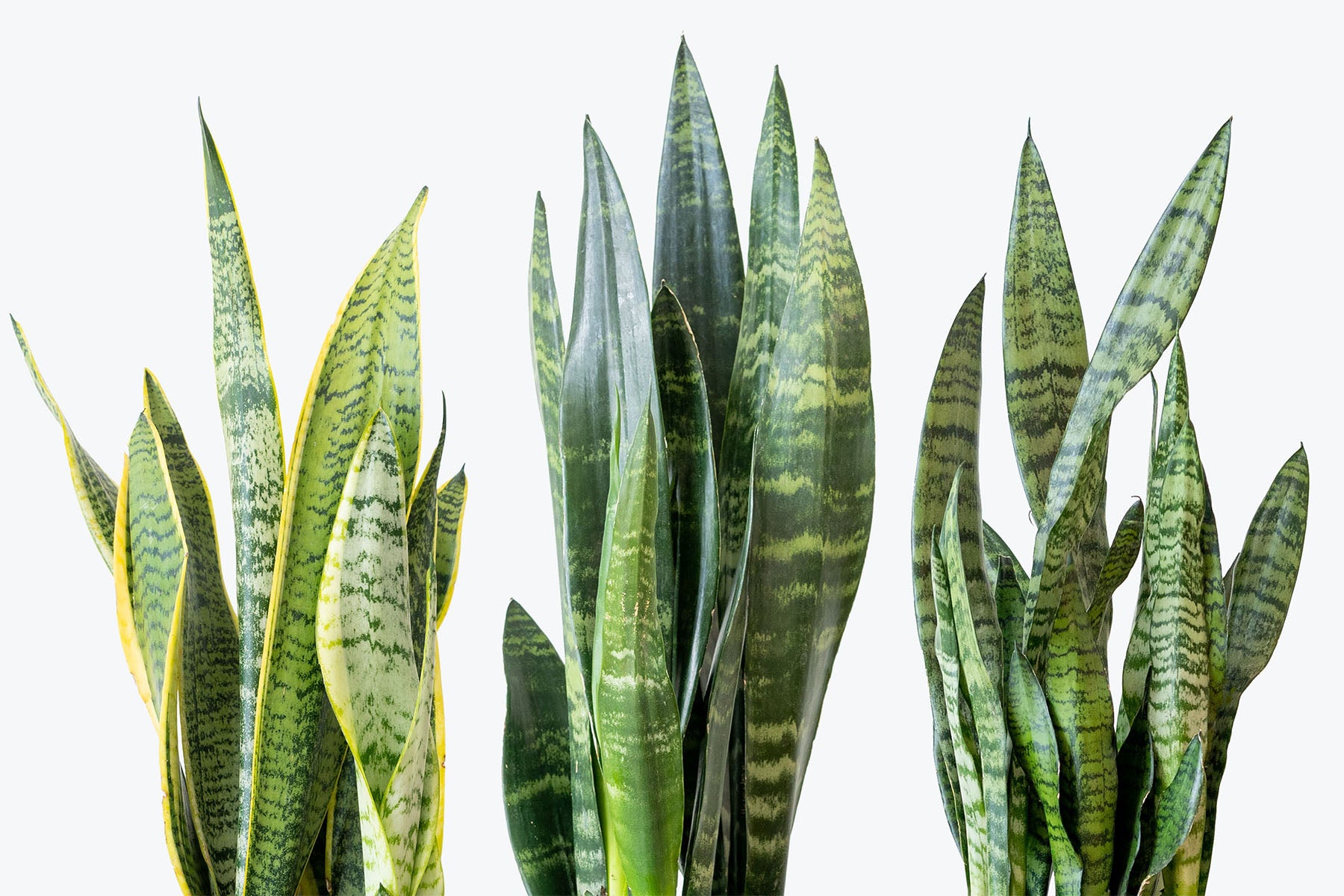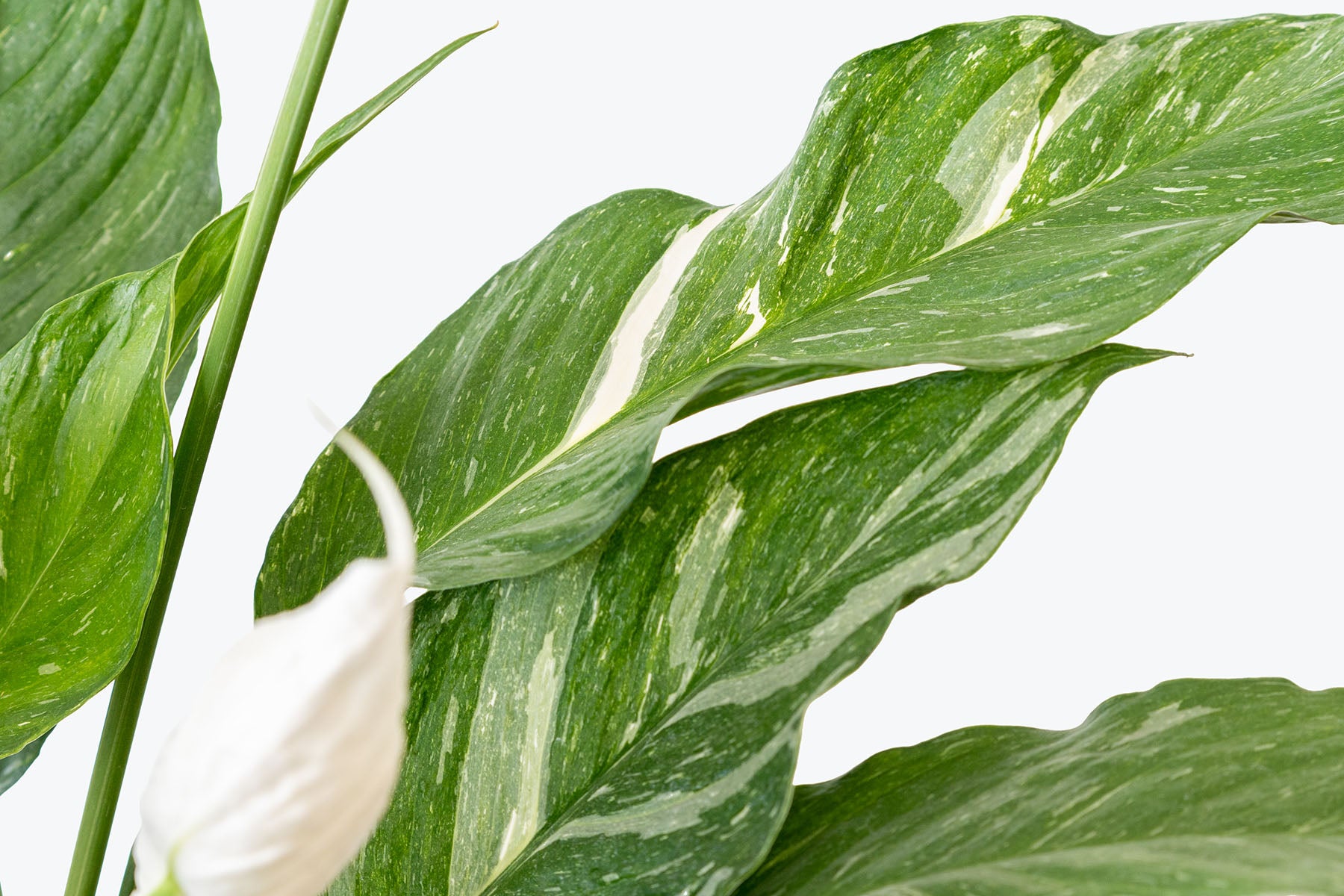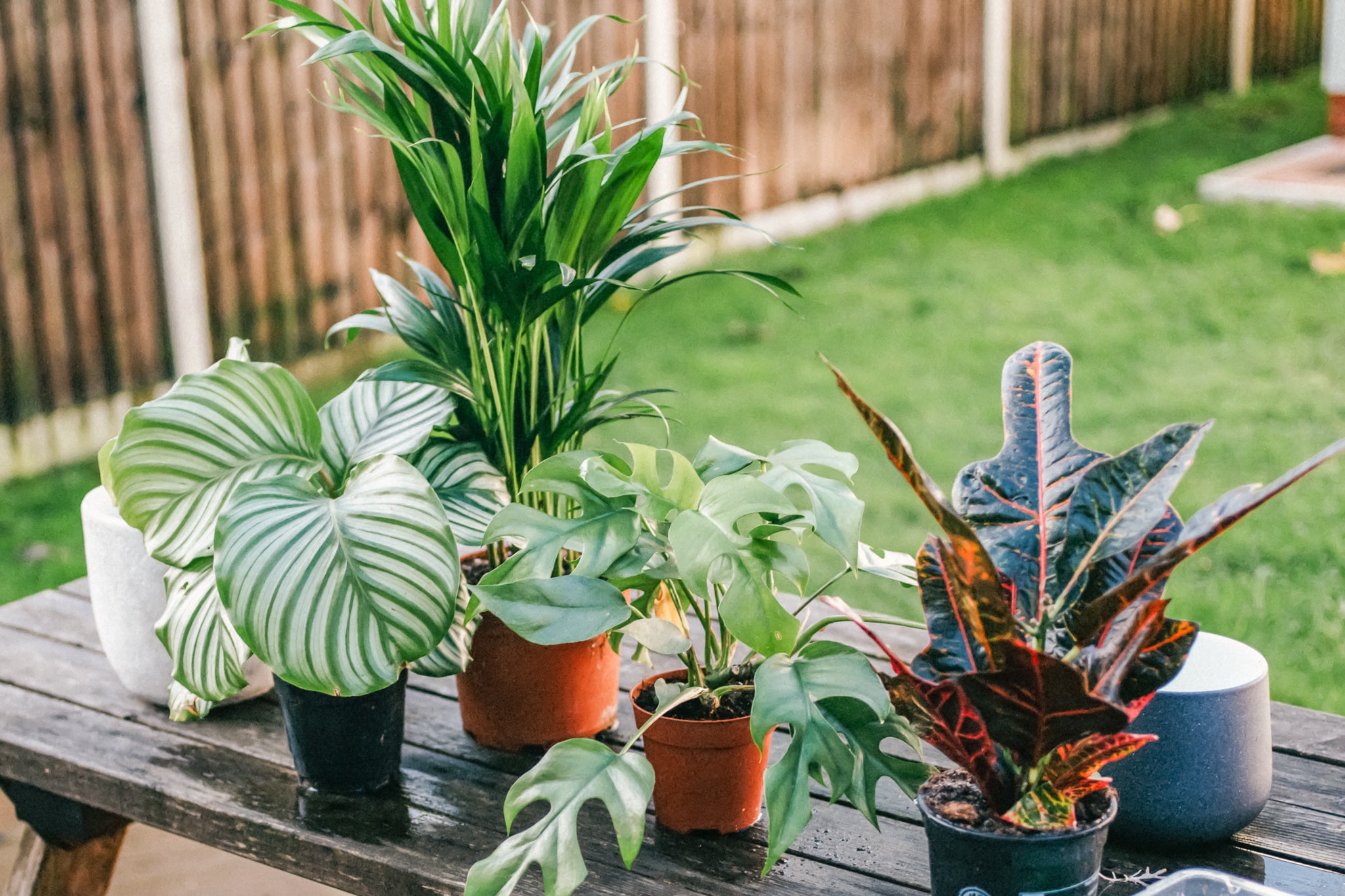
How to Take Care of Your Snake Plant
Coming in as another extremely popular houseplant known for its low maintenance and low light capabilities is the Snake Plant, or Mother-in-Law's Tongue, which is any plant within the Sansevieria genus. Native to Africa, most notably Madagascar, and southern Asia, Snake Plants are incredibly drought tolerant and perfect for the neglectful plant parent. They are nearly indestructible and would much rather you leave them alone most of the time, as long as you don't give them too much water. If you are a frequent traveller or have never owned a plant before, this is the one for you!
△ 14" Sansevieria Laurentii
Although there a few popular varieties, such as Sansevieria trifasciata 'Laurentii' or Sansevieria trifasciata 'Zeylanica', othere are many more options for you to choose from within the genus. Their thick, rigid, sword-shaped leaves can be tall or short, rounded or flat, low-growing or taller florets, there really is a variety out there for everyone. The colouring of their leaves is quite diverse as well, from solid greens to stripes of yellow, grey, cream, or darker shades of green. Depending on the variety, you could have a smaller, dwarf species for your side table or a larger specimen for the floor, reaching heights of at over 3 ft.
📔
The Sansevieria genus of plants is now scientifically classified under the Dracaena genus, we will continue to refer to them as Sansevieria's more often than Dracaena's because that's what the majority of plant parents know them as.
Snake Plants can handle light levels across the spectrum, from very low light all the way up to direct sun outdoors in warmer parts of the world, although both extremes will take their toll on the foliage, ending up with faded or scorched new growth. Where they truly shine is when they are grown in bright, indirect light and receive the right amount of water accordingly.
Not only are they incredibly hardy houseplants, but they also are exceptionally efficient at cleansing the air of formaldehyde and benzene, which are common in cleaning products, toilet paper, tissues and personal care products. They are also on NASA's list of air purifying plants, known for reducing stress, and increasing productivity. Not to mention, Sansevieria are unique in that they perform a specific type of photosynthesis at night, removing carbon dioxide from the air and releasing oxygen throughout the night, unlike most plants which release oxygen during the day. This is one of the main reasons that they are so popular in the bedroom!
✂️
You can propagate Snake Plants via division or cuttings, division being the easier and faster method. You can divide up a plant, or separate the new shoots forming and pot them into a completely new pot! You can also roots stem cuttings in water or soil, either rooting a whole leaf or cutting 2-3" pieces of a leaf and placing them about 1 inch deep in soil/water, making sure to plant cuttings facing up, the same direction they were growing, but they will take quite some time to root.
Virtually indestructible and resilient, Snake Plants can handle low light, infrequent watering, most houseplant soil types, and are practically immune to pests and diseases. If you've never owned a plant before, or wish to get a plant for someone who is new to the houseplant world, any variety of Sansevieria would make an excellent gift.
Light Requirements
When it comes to Snake Plants, they can be placed almost anywhere in your home. From a bright, sunny window all the way down to a windowless room with fluorescent lighting. Although they can handle almost any light on the spectrum of indoor lighting, keep in mind that their growth habits will change depending on the light they are receiving.
△ 6" Sansevieria Bantel's Sensation
Generally, the lower the light a Sansevieria receives, the higher the chances of their new growth being extremely slow, stunted, or pale in colour over time. They are already a rather slow-growing plant, so with lower light, this growth will be even slower. They grow via rhizomes, which are those thick, creeping rootstalks that move horizontally through the soil, retaining the ability to allow new shoots to grow upwards. These are just some things to keep in mind when you place your plant in dimmer settings, because, as with all plant growth, the speed and quality of that growth depend on how much light is received.
🌸
Although it is possible for Snake Plants to flower, they rarely do so indoors and are grown mainly for their foliage. Blooms are usually brought on by neglect or stress, such as little water and plenty of high light levels, when they spread quickly and rapidly become root-bound.
Let’s outline the lowest light conditions that your plant can handle:
- In a windowless room with fluorescent lighting nearby as the only light source
- In the corner of a room with an East, West or South-facing window over 10 ft. away
- A couple meters away from a North-facing window
- Next to a North, East, West, or South-facing window that is facing a courtyard or is blocked by a nearby building or tree
Remember that "thriving off of neglect" is different than "thriving in low light," as most plants do not actually thrive when they receive less light. Of course, there are exceptions, but Snake Plants still like a little light! Although all varieties can handle low light, the following are most popular in those spaces, as their foliage is mainly solid, dark green: Sansevieria 'Black Coral', Sansevieria 'Futura Robusta', Sansevieria 'Zeylanica', Sansevieria 'Starfish', Sansevieria Fernwood Mikado, Sansevieria Cylindrica, Sansevieria Francisii, Sansevieria 'Black Gold', and Sansevieria Masoniana (i.e. Whale Fin Snake Plant).
📋
When it comes to repotting, keep in mind that they prefer to be root-bound, and the frequency of repotting will depend on how much light they are receiving and how quickly they are growing. If the rhizomes are pressing against the walls of the pot and warping it, that is when its home needs to be upsized. They prefer loose, well-draining soil, even some sandier soils as well. You can read all about how to repot in our step-by-step guide here.
Here are some brighter light conditions for your Snake Plant:
- Next to a North, South, East, or West-facing window (keep an eye on their foliage as sometimes, prolonged, direct sun can burn their foliage, but sometimes they love it!)
- Next to, or close by, a South, Southwest, or West-facing window that has sheer curtains for some bright, indirect light
- About 5ft away from a South, Southwest, or West-facing window without curtains
Although bright, indirect light is ideal for Sansevieria's, it is not essential, as your plant will be content almost wherever you place it! No matter where it sits, it is also a great idea to rotate your plant, as this will allow for even growth on all sides. The varieties that are most popular for brighter light spaces, due to their variegation and colouring, are: Sansevieria 'Laurentii', Sansevieria 'Moonshine', Sansevieria 'Golden Hahnii', Sansevieria 'Bantel's Sensation', Sansevieria 'Futura Superba', Sansevieria 'Sayuri', Sansevieria 'Yellowstone', Sansevieria Masoniana Variegata, and Sansevieria 'Night Owl'. That being said, all varieties can handle the full light spectrum, but there are some that are very slightly better suited for certain spaces. They are all just as easy to grow and care for though!
Watering Requirements
Watering is the most important aspect of a Snake Plant's care to get right, as the main thing they will not tolerate is too much water. Only water your plant when the soil is completely dry, which can take from 2-4 weeks, depending on the size of the plant and how much light the plant is receiving. Due to their rhizomatous root system, where they store most of their water (as well as in their thick leaves), they are extremely drought-tolerant and can handle infrequent watering.
🚿
When in doubt, let it dry out! Overwatering is the biggest issue when it comes to Sansevieria's because if the plant receives too much water, rotting and leaf loss will surely occur, as the plant cannot handle excess water. It is much better to let your plant dry out if you are unsure.
This is why it is so important to water your plant accordingly. The Snake Plant that receives bright light will need to be watered more often than the one that resides in a dark corner, and vice versa. No matter where your plant sits, let the soil dry out before watering it again. When the seasons change, adjust your watering again! In the spring and summer months, when the days are longer and brighter, the soil of your plant will dry out quicker than the shorter, darker days of the winter months. In the lowest light settings, this can mean not watering your plant more than once a month.
△ 4" Sansevieria Starfish
When it comes time to water, which you can check by sticking your finger or a wooden chopstick into the soil (if you feel any moisture or see soil stick to the chopstick, hold off on watering), if your plant is in a darker corner, only give it a little water, as you don't want to soak the soil and have your plant sitting in it for too long. If your plant is in brighter light, water your plant fully, until there is water coming out of the drainage holes and the soil has absorbed the water. If the water seems to drain out right away, without absorbing, try bottom-watering instead:
- Fill up a bowl or saucer with water and place the nursery pot into it, letting the water soak up from the bottom holes in the nursery pot
- Once the top layer of the soil is moist, from the water sponging up
- Remove the plant from the bowl and let the excess water drip out before returning it to its decorative pot.
🚨
Avoid letting any water get between leaves (especially varieties that clump), because this can cause the plant to rot when there is stagnant water sitting for long periods of time.
Humidity
Snake Plant's are not too picky when it comes to humidity. That being said, even though they are just fine in average home temperatures they do prefer humid environments as they are still tropicals! So if you have the time, and want to make the effort, you can:
- Place the nursery pot on top of a bed of rocks that are covered in water, which increases the humidity in the air around the plant
- Purchase a humidifier and keep it in the same area as your plant when turned on
Keep in mind that they do prefer warmer temperatures and they don't like cold drafts, heating vents, or AC vents!
Fertilizing
To add to the list of reasons why Snake Plants are so low maintenance, they are fairly light feeders and don’t require too much when it comes to fertilizing. It is best to fertilize twice through the spring and summer months and then do not fertilize throughout the winter. Just use a mild cactus fertilizer or a balanced (10-10-10), liquid fertilizer diluted to half strength that any greenhouse, garden centre, or plant shop offers! Always make sure the soil is evenly moist before fertilizing any of your plants
Toxicity
Since they are moderately toxic to both humans and pets, it is best to not let children or pets munch on your plants, which we advise for all plants in general. If ingested, and depending on how much, they can cause mouth or stomach irritation, which can lead to mouth pain, salivation, nausea, possible vomiting, and in some rare cases, skin issues.
Common Pests & Problems
Finally, Snake Plants don't have a lot of problems when it comes to pests and other issues. As long as the plant is not being stressed and is receiving the care that it needs, it should do just fine. Even though most of these problems don't occur all the time, we still want to outline any possible issues you could experience while having them in your care:
Southern blight:
This is the most common fungal disease to affect Sansevieria. If you ever notice brown, wet, sore-like spots anywhere on the leaves, then the fungus is most likely present. It is airborne, meaning that it can spread through the plant and any other plant nearby (predominantly snake plants though), so make sure to remove any sections of the plant with clean shears. Do not touch a spot and then touch another section of the plant as this can also help the fungus spread. There is no fungicide that can fix it so any damaged sections need to be removed.
Under-watering:
If you notice wrinkled leaves, extremely dry soil (where it is pulling away from sides of pot), limp or drooping leaves, and leaf tips are possibly start to brown and curl, your plant may not be receiving enough water. Try bottom watering, as we describe above in the Watering Requirements and then let it drain thoroughly in the sink.
Over-watering:
If you notice soggy or mushy leaves, extremely wet potting soil, or folding leaves, your plant may be receiving too much water. If the rotting has not gone too far, let the plant dry out fully between waterings from now on.
Yellowing foliage:
If this is not due to watering issues, your plant may have a spider mite or mealybug infection, make sure to check through the leaves to see if there are any pests on your plant. They are sap-sucking insects, so they will drain your plant of moisture and their piercing mouths will accelerate the yellowing, especially if the plant is already unhealthy from moisture issues or nutrient deficiency. See our complete pest guide here.
Pale new growth:
This is due to the plant not receiving enough light, so simply move it to a location that receives more!
When a plant is stressed or weakened, which can occur from overwatering, under-watering, or fungal infections, they can become more susceptible to pests. Going from bone dry soil to fully saturated soil can also stress out a plant, as it is going from one extreme to another, so make sure to care for your plant accordingly, as a stressed plant will attract unwanted pests.
With all that being said, Snake Plants are a great addition to your home because they are incredibly strong, lower light plants and they are a breeze to take care of, just don't take a bite of one!









